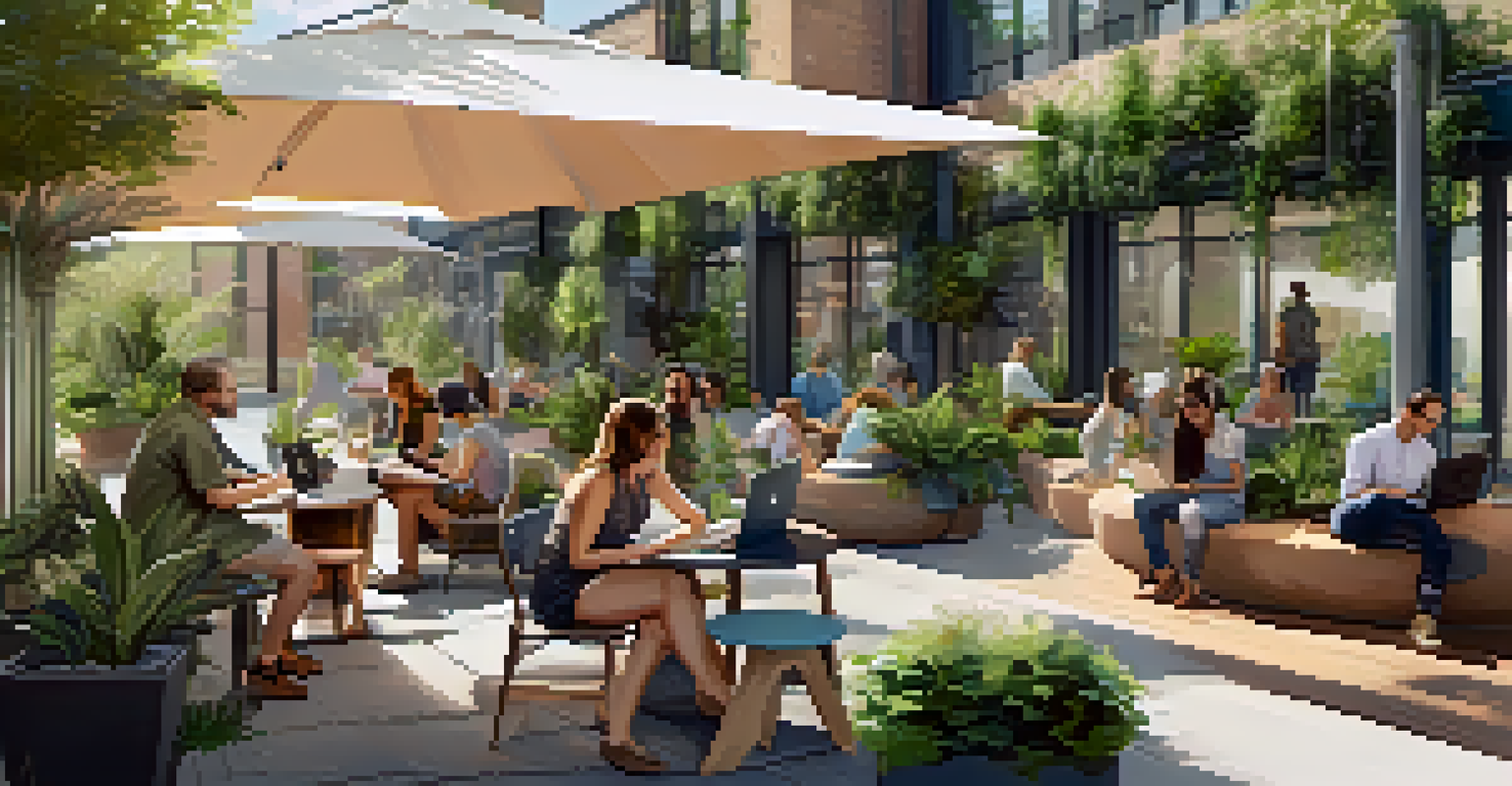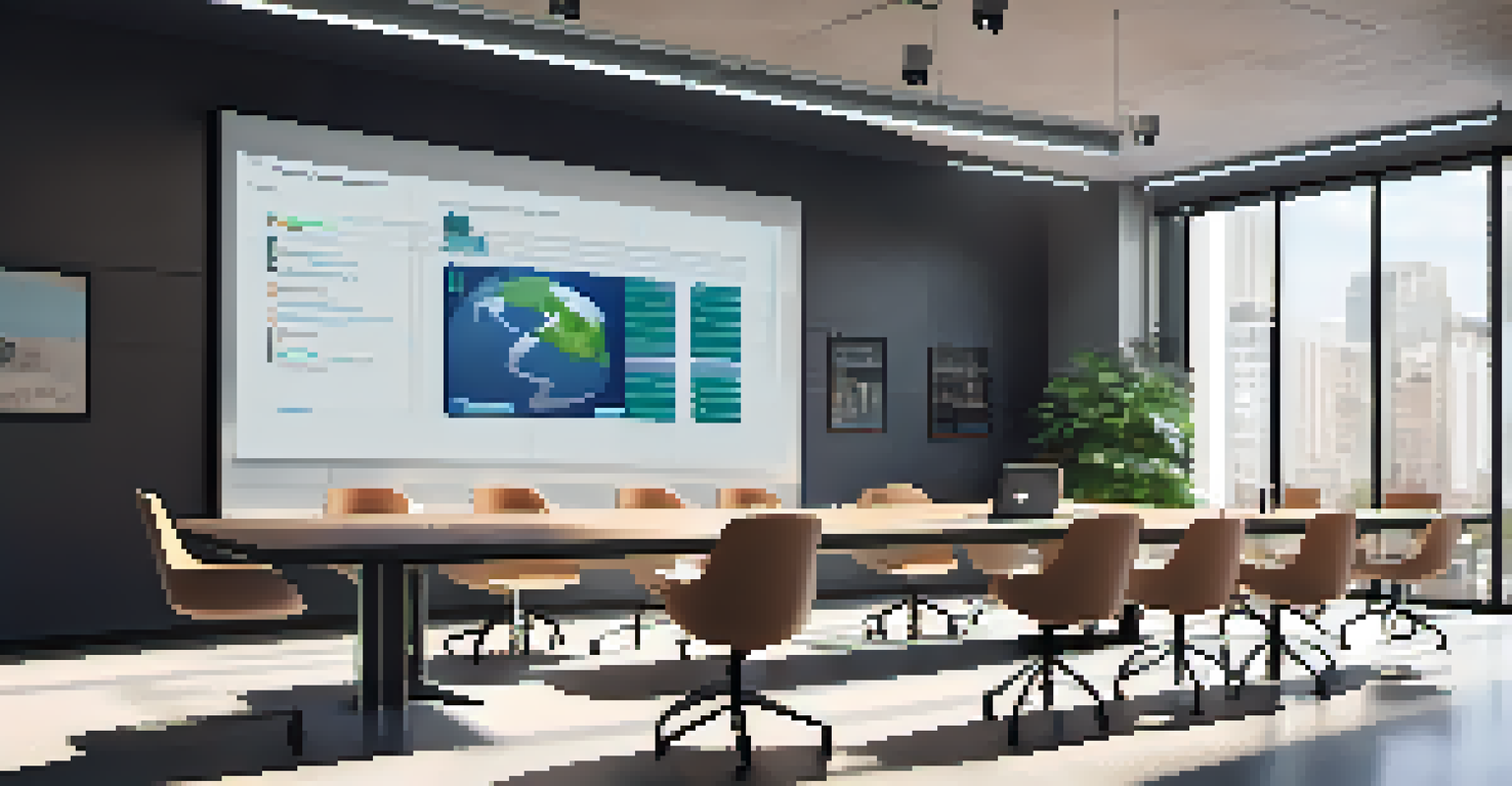Current Trends in Co-Working Spaces: Real Estate Insights

The Rise of Flexible Workspaces in a Post-Pandemic World
Co-working spaces have surged in popularity since the pandemic, as many companies have embraced flexible work arrangements. Remote work has become a norm for many employees, leading to a demand for adaptable office solutions. This shift has redefined traditional office spaces, making flexibility a priority for businesses of all sizes.
The future of work is not about where you work but how you work.
As a result, co-working spaces are now designed to cater to diverse needs, offering various layouts and amenities. From hot-desking to private offices, these spaces provide options that encourage collaboration while also allowing for personal work preferences. This flexibility not only attracts startups but also established companies looking for cost-effective solutions.
Moreover, the focus on well-being has prompted co-working spaces to incorporate features like wellness rooms, outdoor areas, and ergonomic furniture. These enhancements create a more inviting environment, helping to boost productivity and employee satisfaction. As we move forward, the interplay between flexibility and well-being will likely shape the future of workspaces.
Sustainability: A Key Focus for Co-Working Design
Sustainability is becoming a cornerstone of co-working space design, responding to increasing environmental awareness. Many operators are now prioritizing eco-friendly materials and energy-efficient systems to reduce their carbon footprint. This approach not only appeals to environmentally-conscious tenants but also aligns with global sustainability goals.

For instance, some co-working spaces are utilizing renewable energy sources, like solar panels, to power their operations. Additionally, the implementation of biophilic design—incorporating natural elements such as plants and natural light—enhances the workspace experience. Such designs not only create a healthier environment but also contribute positively to employee well-being.
Flexible Workspaces Are Here to Stay
The rise of remote work has led to a demand for adaptable co-working spaces that cater to diverse needs and promote employee well-being.
As businesses look to align with sustainability initiatives, co-working spaces that prioritize green practices could see a competitive edge. This trend is likely to influence real estate decisions, as companies seek spaces that reflect their values and commitment to sustainability.
The Role of Technology in Shaping Co-Working Spaces
In today’s digital world, technology is a pivotal element in co-working spaces, enhancing both functionality and user experience. High-speed internet, advanced communication tools, and smart meeting rooms are just a few examples of how tech is integrated into these environments. This connectivity allows for seamless collaboration, whether teams are working remotely or in person.
Sustainability is no longer a choice; it is a responsibility.
Moreover, many co-working spaces are leveraging data analytics to optimize their offerings. By analyzing usage patterns, operators can make informed decisions about layout adjustments or service enhancements. This data-driven approach ensures that the space continues to meet the evolving needs of its users.
As technology continues to advance, we can expect to see even more innovative solutions in co-working spaces. From virtual reality meeting tools to AI-driven member services, the integration of tech will not only enhance productivity but also redefine the work experience in shared environments.
Community Building: The Heart of Co-Working Spaces
At its core, the success of a co-working space lies in its community. Operators are increasingly focused on fostering a sense of belonging among members, understanding that collaboration and networking can lead to business opportunities. Regular events, workshops, and social gatherings are common strategies to enhance community engagement.
This emphasis on community is particularly beneficial for freelancers and small businesses, who often seek connection and support. By providing a platform for networking, co-working spaces help individuals to build relationships that can lead to collaborations or partnerships. This community aspect is not only about professional growth but also about personal connections.
Sustainability Shapes Workspace Design
Eco-friendly materials and energy-efficient systems are becoming essential in co-working spaces, appealing to environmentally-conscious tenants.
As the landscape of work continues to evolve, the importance of community in co-working spaces will only grow. Spaces that prioritize relationship-building and collaboration will likely attract more members, reinforcing the idea that a vibrant community is essential for a thriving co-working environment.
The Impact of Location on Co-Working Space Success
Location is a critical factor in the success of co-working spaces. Urban areas with a high concentration of businesses and talent attract more users, making them prime locations for co-working setups. Proximity to public transportation, amenities, and vibrant neighborhoods can significantly enhance the appeal of these spaces.
Additionally, operators are increasingly considering the needs of their target audience when choosing locations. For example, tech startups may thrive in areas known for innovation, while creative industries might prefer neighborhoods with a cultural flair. This strategic approach ensures that co-working spaces cater to the specific demographics of their members.
As remote work continues to rise, the concept of location may also evolve. Operators might explore suburban or even rural locations, offering a balanced alternative to urban density. This shift could open new markets for co-working spaces, as individuals seek environments that foster both productivity and a connection to nature.
The Evolution of Amenities in Co-Working Spaces
Amenities play a pivotal role in the attractiveness of co-working spaces, evolving beyond basic necessities to include a range of lifestyle offerings. Modern co-working environments often feature coffee bars, fitness centers, and relaxation areas, creating a holistic experience for members. This evolution reflects the changing expectations of today’s workforce who value work-life balance.
Moreover, spaces are also beginning to offer services like childcare, pet-friendly areas, and wellness programs. These amenities cater to diverse needs, making co-working spaces appealing to a wider audience. By addressing various lifestyle demands, operators can attract and retain a broader membership base.
Community Engagement Drives Success
Fostering a sense of belonging through networking and collaboration is crucial for the success of co-working spaces, especially for freelancers and small businesses.
As competition in the co-working industry increases, the focus on innovative amenities will likely intensify. Spaces that provide unique offerings can set themselves apart, ensuring that they remain relevant and attractive to potential members. Ultimately, the right amenities can enhance the overall experience, fostering loyalty among users.
Trends in Membership Models for Co-Working Spaces
The membership models for co-working spaces are becoming increasingly diverse, reflecting the varying needs of users. Traditional monthly memberships are now complemented by flexible options, such as pay-as-you-go or day passes, allowing greater accessibility. This flexibility caters to freelancers and remote workers who may not require full-time office space.
Additionally, some co-working spaces are adopting tiered membership structures, offering different levels of access and amenities. This allows members to choose a plan that aligns with their specific needs, whether they require a dedicated desk or occasional meeting room access. Such customization is appealing in today’s dynamic work environment.

As the demand for flexible and adaptive workspaces grows, we can expect to see further innovation in membership models. Operators who can effectively respond to the changing landscape will likely thrive, ensuring that they attract a diverse range of members who value flexibility and choice.
The Future of Co-Working Spaces in Real Estate
The future of co-working spaces in real estate looks promising, as more companies recognize the benefits of flexible workspace solutions. With hybrid work models on the rise, the demand for co-working spaces is expected to grow, reshaping how commercial real estate is approached. This shift could lead to a transformation of traditional office spaces into collaborative environments.
Furthermore, the integration of co-working spaces into mixed-use developments is likely to become more common. By combining residential, retail, and office spaces, developers can create vibrant communities that cater to the needs of modern workers. This trend not only enhances the appeal of real estate projects but also fosters a sense of community.
As we look ahead, the adaptability and innovation of co-working spaces will play a vital role in the future of real estate. Operators and developers who embrace these trends will be well-positioned to meet the evolving needs of businesses and individuals alike, creating spaces that foster collaboration, productivity, and community.